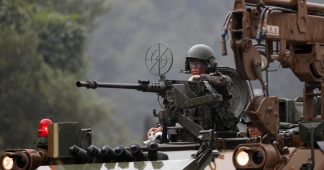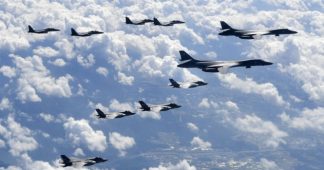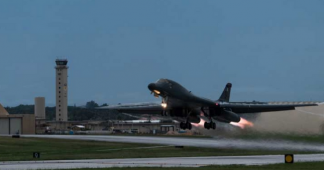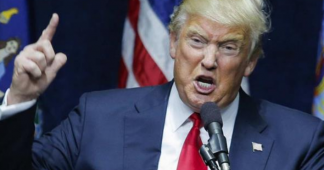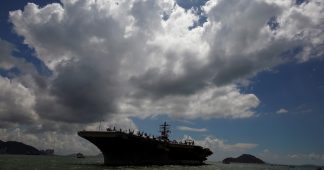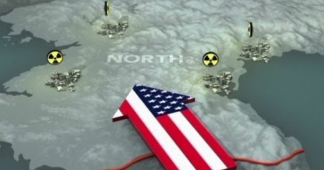Trump and Kim’s brinkmanship raises the danger of an accidental conflict on the Korean Peninsula.
By Dan De Luce, Jenna McLaughlin, Elias Groll
Rising tensions between North Korea and the United States have sparked fresh concerns inside and outside the Pentagon that a potential miscalculation — driven by heated rhetoric or technical mistakes — could lead to an accidental conflict on the Korean Peninsula.
The danger of an inadvertent clash is exacerbated by two impulsive nuclear-armed leaders, who have publicly traded threats, and a volatile mismatch between the United States’ overwhelming military superiority and an isolated regime in Pyongyang.
The recent war of words appears to be shortening the fuse, with U.S. forces in the area put on heightened alert. After a North Korean missile test in mid-September, a U.S. warship patrolling the Sea of Japan received a warning order, or WARNO, to be prepared to fire Tomahawk missiles at North Korean targets, a military source told Foreign Policy.
“It’s not unheard of to do that,” a former senior defense official said of the order to prepare the cruise missiles. “But I would say it is a fairly significant indicator that the possibility of using Tomahawks is rising.”
A WARNO is essentially an instruction to forces to be at the ready if ordered to take action. For Tomahawks, that means prepping the weapon and programming a target; surface ships and submarines in the area are armed with dozens of the cruise missiles.
Military officials declined to speculate on what scenarios could involve the launching the missiles, which were used this summer against a Syrian airfield that served as a staging ground for chemical weapons attacks. If North Korea launched missiles at Guam, Japan, or South Korea, “you would certainly want your Tomahawks ready in a fast-moving scenario like that should the president or secretary of defense make the judgement to respond with an offensive strike,” said the former senior official, who is familiar with Pentagon contingency planning.
Former military officers said such an order did not mean U.S. military action was imminent, only that commanders were taking precautions to be ready with an array of weapons if a conflict erupted. Before contemplating launching the powerful cruise missiles, the United States likely would first weigh less drastic options, including cyber warfare or a naval blockade, former officers said.
“The WARNO is to force staffs to think through the problems, but not to actually do anything other than think,” Ted Johnson, a former naval commander and current fellow at New America, told FP. “The fact that it’s for a Tomahawk strike into [North Korea] feels ominous, but my guess it’s more about having a quick strike response should ‘Rocket Man’ make an irrational decision and overt provocation.”
The Defense Department declined to discuss contingency plans or the status of Tomahawks or other weapons systems in Northeast Asia. “The U.S. military must always maintain a high state of readiness to counter any threat, to include those from North Korea,” a U.S. official told FP.
The be-prepared order for U.S. forces came on the heels of a series of provocative missile launches and a nuclear test by the rogue power. On July 3, North Korea launched an intercontinental ballistic missile capable of hitting U.S. territory. Two months later, North Korea tested what it described a thermonuclear weapon, a claim that if true would vastly increase the destructive power of Pyongyang’s nuclear arsenal.
By September, U.S. President Donald Trump and North Korean leader Kim Jong Un were trading insults. Trump called Kim “Little Rocket Man” and was labelled a “mentally deranged dotard” in return.
Arms control experts and retired senior military officers worry that taunts from Washington could prompt North Korea to take more provocative action. The country’s foreign minister last month said Kim is contemplating detonating a nuclear-tipped missile over the Pacific, an aggressive move that could force a military response from Washington.
“The miscalculation risk is another deeply humiliating remark from President Trump putting Kim Jong Un in an untenable position because his elites will view him as weak if he doesn’t respond,” a former senior military officer told FP, speaking on condition of anonymity to candidly assess the risk of war.
“Over-the-top rhetoric could result in a tit-for-tat in which leaders overreact and escalation gets out of control … Leaders have stumbled into war before, but it’s never been between two nuclear-armed powers,” he added.
Defense Secretary James Mattis has warned that any threat to the United States, including the territory of Guam, or to U.S. allies would be met with “a massive military response.” And Mattis said last month that that response needn’t jeopardize U.S. and Korean civilians in Seoul, but he declined to say what those military options could be.
Washington has conducted military drills with South Korean and Japanese allies, sent attack submarines to South Korean ports, and flown strategic bombers over South Korea and off the North Korean coast.
Yet Kim and his predecessors have avoided the ultimate showdown despite plenty of low-intensity skirmishes over the years. That’s a sign that the regime has an overarching focus on survival, said Yong Suk Lee, deputy assistant director at the CIA’s new Korea Mission Center.
“The last person who wants conflict is actually Kim Jong Un. He wants to rule peacefully for a long time and die,” Lee said. Taking on the United States is “not conducive to his longevity.”
During the Cold War, there were plenty of close calls and near misses that almost led to a conflagration between the United States and the Soviet Union, including an infamous 1983 NATO exercise, Operation Able Archer, that convinced Moscow it was about to come under nuclear attack.
But unlike the U.S.-Soviet contest between two equally matched rivals, the Korean crisis pits the world’s most powerful military against an impoverished, isolated, but nuclear-armed regime. In that mismatch, the stronger side could convince itself it can impose its will against a weaker side that has few options but to go nuclear. Trump, for example, last week boasted that U.S. missile defenses are nearly invincible, even though the technology remains unreliable.
That could make a preemptive strike look more tempting than it really is, experts said.
In the current crisis, senior U.S. officials along with the chairman of the Joint Chiefs of Staff, Gen. Joseph Dunford, have stressed that the Trump administration is focused on tackling the crisis with North Korea through diplomacy. But the White House has said that military action has not been ruled out.
Lyle Goldstein, an associate professor at the U.S. Naval War College, has studied how the prospect of disarming a foe can shape decision-making. In his dissertation, Goldstein looked at the calculus of former Presidents John F. Kennedy and Lyndon Johnson, who both mulled a surprise attack against China to deprive Beijing of its nascent nuclear arsenal. In the end, fearing China would wade into Vietnam in full force, the United States chose not to strike.
Goldstein describes the imbalance now playing out between North Korea and the United States as a similar “valley of vulnerability.”
